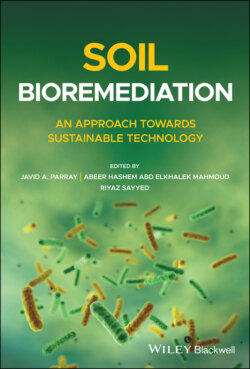Читать книгу Soil Bioremediation - Группа авторов - Страница 14
1.3 In‐situ Bioremediation Techniques 1.3.1 Bioaugmentation
ОглавлениеSuccessful bioremediation processes require the use of various strategies for the specific environmental conditions of polluted sites. The most frequently used bioaugmentation strategy is the addition of a pure bacterial strain that is preadapted or the addition of a preadapted consortium that has been genetically engineered through adding biodegradation relevant genes to them [51]. Feasibility studies are a prerequisite for any planned intervention. They usually revolve around screening, followed by tailoring of a competent microbial formula for a particular site. The screening must be based on the ability of the microbes and also on the factors that enable the cells to be activated and persistent under the particular environmental conditions. In order to select the competent microbe it is crucial to have prior knowledge of microbes [23, 52]. Once the contamination is of both high metal concentrations and organic pollutants, the degradation of organic compounds may be constrained by co‐contaminants [53]. The use of a multicomponent system such as a microbial consortium gives a better performance in the environment than single component systems [54]. It is more advantageous to use a microbial consortium instead of a pure culture, because it provides metabolic diversity to the remediation technology and obtains complete degradation of diesel oil and phenanthrene: a reduction of 60% of isoprenoids and an overall reduction of about 75% of the total hydrocarbons in 42 days, using a microbial formula made with selected native strains [55–57]. The indigenous microbes degrade PAH in polluted soil after adding microbial consortia (five fungi: Phanerochaete chrysosporium, Cuuning hamella sp., Alternaria alternate (Fr.) Keissler, Penicillium chrysogenum, and Aspergillus niger; and three bacteria: Bacillus sp., Zoogloea sp., and Flavobacterium) that enhanced the degradation rate significantly (41.3%) [57, 58]. Microbial inoculants produced under optimum conditions are homogeneous cell suspensions, which usually suffer stress when introduced in a variety of natural habitats. After these populations are introduced to a diversity of biotic and abiotic stresses they start declining at a rapid rate. These stresses include temperature changes, moisture content, pH, nutrient decline, and also harmful contaminants in polluted soil [59].
The microorganisms have a great ability to decontaminate organic pollutants in cultures but they fail to degrade the pollutants in natural environments. The various possible reasons for the failure of the bioaugmentation process is either: inoculated microorganisms facing several problems in adapting to the natural conditions or competition between inoculated and native organisms; or the use of other biological substances and predation by grazing protozoa [60]. Consequently, seeding alone is not enough but it should be supplemented with some physical and environmental modifications [61]. The various factors that influence the efficiency of bioaugmentation and biostimulation are given in Table 1.1. The use of carrier materials often provides a physical support for biomass, along with improved access to nutrients, moisture, and aeration, which increases the survival rate of the microbes [62]. Encapsulation of microbial cells offer good survival rates under harsh environments and thus makes the rate of degradation very rapid and efficient when compared to free‐living microbes [63, 64]. Encapsulation controls the flow of nutrients, lowers the concentration of toxic mixtures in the microenvironment of the cells, minimizes cell membrane damage as it reduces the exposure to the toxic compounds, and protects from predation and competition thereby impersonating a miniature bioreactor in the environment [65]. Various materials like agar, agarose, alginate, gelatin, gellan gum, kappa‐carrageenan, acrylate copolymers, and polyvinyl alcohol gel have been studied and verified to immobilize cells [66]. Immobilized cells showed a smaller lag phase and thus a higher degradation of gasoline when compared to free cell counterparts at equal microbial applications [63]. The biodegradation of phenol by free and immobilized cells of Acinetobacter sp. XA05 and Sphingomonas sp. FG03 strains collected from activated sludge and phenol contaminated soil were compared with pure cultures and it was found that the mixture of Acinetobacter sp. XA05 and Sphingomonas sp. FG03 strains performed better than pure cultures and encapsulated cells achieved better phenol degradation [58].
Table 1.1 Various aspects affecting in‐situ bioremediation.
| Aspects | Depiction | References |
| Microbial viability loss during inoculation | Sudden changes in environmental conditions | [67] |
| Death of microbes after inoculation | Presence of toxic pollutants and nutrient depletion | [58, 60] |
| Competition | Competition for nutrients by autochthonous microbes | [23, 51] |
| Predation | Overgrowth of protozoa | [68] |
| pH | pH change inhibits growth of microbes | [69] |
| Temperature | Affects the nature of oil vis a vis microorganisms | [70] |
| Moisture | Growth and metabolism are lowered by low moisture content and higher moisture content reduces aeration | [61, 69] |
